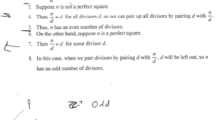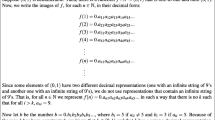Abstract
Although proof comprehension is fundamental in advanced undergraduate mathematics courses, there has been limited research on what it means to understand a mathematical proof at this level and how such understanding can be assessed. In this paper, we address these issues by presenting a multidimensional model for assessing proof comprehension in undergraduate mathematics. Building on Yang and Lin’s (Educational Studies in Mathematics 67:59–76, 2008) model of reading comprehension of proofs in high school geometry, we contend that in undergraduate mathematics a proof is not only understood in terms of the meaning, logical status, and logical chaining of its statements but also in terms of the proof’s high-level ideas, its main components or modules, the methods it employs, and how it relates to specific examples. We illustrate how each of these types of understanding can be assessed in the context of a proof in number theory.
Similar content being viewed by others
Notes
We note that there were two related types of proof comprehension mentioned by mathematicians that were not discussed in the mathematics education research literature—recognizing where a proof becomes non-routine or difficult, and recognizing why the obvious approach to proving a particular theorem fails.
The proof used in this paper introduces new terminology such as “triadic,” but as the following question illustrates, one need not only ask about new terminology.
In this sense, this aspect of proof comprehension sometimes differs from the “surface level” described by Yang and Lin. This difference is due, in part, to the content of proofs in high school geometry and advanced mathematics. It is uncommon to create new terminology for a specific proof in high school geometry.
A proof might have several methods. However, we anticipate that many proofs for which one would test students’ comprehension have a fairly well-delineated method.
To avoid students answering this question by matching symbols rather than using a deep understanding, one could also ask the student to justify why this choice of M was appropriate or to present them with a poor choice of M and ask why the proof would not work in that case.
References
Alcock, L. (2009). e-Proofs: Students experience of online resources to aid understanding of mathematical proofs. In Proceedings of the 12 th Conference for Research in Undergraduate Mathematics Education. Available for download at: http://sigmaa.maa.org/rume/crume2009/proceedings.html. Last downloaded January 20, 2011.
Alcock, L., & Weber, K. (2005). Proof validation in real analysis: Inferring and checking warrants. The Journal of Mathematical Behavior, 24, 125–134.
Alibert, D., & Thomas, M. (1991). Research on mathematical proof. In D. Tall (Ed.), Advanced Mathematical Thinking (pp. 215–230). Dordrecht: Kluwer.
Anderson, J. R., Boyle, C. F., & Yost, G. (1986). The geometry tutor. The Journal of Mathematical Behavior, 5, 5–19.
Conradie, J., & Frith, J. (2000). Comprehension tests in mathematics. Educational Studies in Mathematics, 42, 225–235.
Davis, P. J., & Hersh, R. (1981). The Mathematical Experience. Boston: Birkhäuser.
De Villiers, M. (1990). The role and function of proof in mathematics. Pythagoras, 24, 17–24.
Fuller, E., Mejia-Ramos, J. P., Weber, K., Samkoff, A., Rhoads, K., Doongaji, D., Lew, K. (2011). Comprehending Leron’s structured proofs. In Proceedings of the 14th Conference for Research in Undergraduate Mathematics Education.
Hanna, G. (1990). Some pedagogical aspects of proof. Interchange, 21(1), 6–13.
Hanna, G., & Barbeau, E. (2008). Proofs as bearers of mathematical knowledge. ZDM, 40, 345–353.
Hersh, R. (1993). Proving is convincing and explaining. Educational Studies in Mathematics, 24, 389–399.
Leron, U. (1983). Structuring mathematical proofs. The American Mathematical Monthly, 90(3), 174–184.
Malek, A., & Movshovitz-Hadar, N. (2011). The effect of using transparent pseudo proofs in linear algebra. Research in Mathematics Education, 13(1), 33–58.
Mamona-Downs, J., & Downs, M. (2005). The identity of problem solving. The Journal of Mathematical Behavior, 24, 385–401.
Mejia-Ramos, J. P., & Inglis, M. (2009). Argumentative and proving activities in mathematics education research. In F.-L. Lin, F.-J. Hsieh, G. Hanna, & M. de Villiers (Eds.), Proceedings of the ICMI Study 19 conference: Proof and Proving in Mathematics Education (Vol. 2, pp. 88–93). Taipei, Taiwan.
Raman, M. (2003). Key ideas: What are they and how can they help us understand how people view proof? Educational Studies in Mathematics, 52, 319–325.
Rav, Y. (1999). Why do we prove theorems? Philosophia Mathematica, 7(3), 5–41.
Resnick, L. B., & Resnick, D. P. (1992). Assessing the thinking curriculum: New tools for educational reform. In B. R. Gifford & M. C. O'Connor (Eds.), Changing assessments: Alternative views of aptitude, achievement, and instruction (pp. 37–75). Boston: Kluwer.
Rowland, T. (2001). Generic proofs in number theory. In S. Campbell & R. Zazkis (Eds.), Learning and teaching number theory: Research in cognition and instruction (pp. 157–184). Westport: Ablex.
Roy, S., Alcock, L., & Inglis, M. (2010). Undergraduates proof comprehension: A comparative study of three forms of proof presentation. In Proceedings of the 13th Conference for Research in Undergraduate Mathematics Education. Available for download from: http://sigmaa.maa.org/rume/crume2010/Abstracts2010.htm
Schoenfeld, A. H. (1988). When good teaching leads to bad results: The disasters of “well-taught” mathematics courses. Educational Psychologist, 23(2), 145–166.
Selden, J., & Selden, A. (1995). Unpacking the logic of mathematical statements. Educational Studies in Mathematics, 29, 123–151.
Selden, A., & Selden, J. (2003). Validations of proofs considered as texts: Can undergraduates tell whether an argument proves a theorem? Journal for Research in Mathematics Education, 34(1), 4–36.
Thurston, W. (1994). On proof and progress in mathematics. Bulletin of the American Mathematical Society, 30(2), 161–177.
Weber, K. (2002). Beyond proving and explaining: Proofs that justify the use of definitions and axiomatic structures and proofs that illustrate technique. For the Learning of Mathematics, 22(3), 14–17.
Weber, K. (2009). Mathematics majors’ evaluation of mathematical arguments and their conception of proof. In Proceedings of the 12 th Conference for Research in Undergraduate Mathematics Education. Available for download at: http://sigmaa.maa.org/rume/crume2009/proceedings.html. Last downloaded April 10, 2010.
Weber, K. (2010). Proofs that provide insight. For the Learning of Mathematics, 30(1), 32–36.
Weber, K. (2011). The pedagogical practice of mathematicians. International Journal of Mathematics Education in Science and Technology, in press.
Weber, K., & Alcock, L. (2005). Using warranted implications to understand and validate proofs. For the Learning of Mathematics, 25(1), 34–38.
Weber, K., Brophy, A., & Lin, K. (2008). How do undergraduates learn about advanced mathematical concepts by reading text? In Proceedings of the 11 th Conference on Research in Undergraduate Mathematics Education. San Diego.
Weber, K., & Mejia-Ramos, J. P. (2011). Why and how mathematicians read proofs. Educational Studies in Mathematics, 76, 329–344.
Yang, K.-L., & Lin, F.-L. (2008). A model of reading comprehension of geometry proof. Educational Studies in Mathematics, 67, 59–76.
Acknowledgements
This material is based upon work supported by the National Science Foundation under Grant No. DRL0643734.
Author information
Authors and Affiliations
Corresponding author
Rights and permissions
About this article
Cite this article
Mejia-Ramos, J.P., Fuller, E., Weber, K. et al. An assessment model for proof comprehension in undergraduate mathematics. Educ Stud Math 79, 3–18 (2012). https://doi.org/10.1007/s10649-011-9349-7
Published:
Issue Date:
DOI: https://doi.org/10.1007/s10649-011-9349-7




